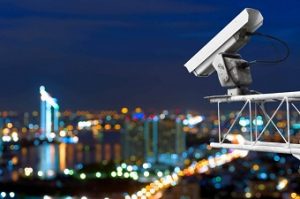
The warehousing industry is witnessing a large-scale transformation in operations with the introduction of new technological tools like IoT devices, cloud computing, Artificial Intelligence & Machine Learning backed analytics. These tools are redefining the way warehouses operate. From incoming inventory to storage to dispatch, all activities can be refined and optimized using these tools.
Labour costs constitute, on average, 65% of most warehouse facilities’ operating budgets. Introducing these technologies can help significantly reduce labour required and hence bring down operating costs. This article will take you through all these technologies, explain them in detail, and describe how they can be used to maintain warehouse security.
Internet of things
IoT devices are a network of wirelessly connected devices embedded with sensors, cameras, alarms, etc., to connect and exchange data with other devices and systems over the Internet. In an e surveillance solution, these devices are usually embedded within CCTV cameras, motion sensors, door sensors, smoke detectors, vibration sensors to facilitate remote control and monitoring over these devices. Some devices and how they function as intelligent devices are explained below.
IP Cameras
These cameras are used across the facility to monitor and record all activities. They work in tandem with multiple sensors and access control systems to provide verification and support. For example, if a smoke sensor goes off, a camera near the sensor is used to verify whether there is a fire or not. Besides warehouse security, these IP installations can also provide other functionalities. For example, in a warehouse, smart cameras can be used at GRN tables to monitor and keep track of inbound and outbound inventory. They can autonomously measure inventory and instantly report any discrepancies.
Motion Sensors
These devices are used to detect unwanted movement within the premises. The sensors can be used on any floor or room where access is restricted. Any motion detected by them sends a notification to the command center for further action.
Access Control System
This is a set of devices used at entrances and doors to verify personnel and grant access based on authority. Especially important for sensitive areas, these systems can be used to allow or restrict entry to particular employees, eliminating the need for keys and locks. They can also be set according to time, meaning the door only grants access to the employees between the working hours and not after that. Any access to these doorways after acceptable hours gets notified in real-time. They can be accessed remotely to provide access under particular circumstances.
Warehouse Automation
Warehouse automation is the process of automating inventory movement into, within, and out of warehouses to customers with minimal human assistance. As part of an automation project, a business can eliminate labour-intensive duties that involve repetitive physical work and manual data entry and analysis. These devices can be used to automate environment control like temperature, cold storage, air quality, dust, and CO2 levels across the warehouse. Suppose the CO2 or dust particulate levels increase beyond the predefined threshold. In that case, they can directly switch on the exhaust system till the levels decrease or notify relevant personnel to switch on the exhaust system.
Artificial Intelligence & Machine Learning
Artificial Intelligence and Machine Learning algorithms can be used on the data collected through cameras and various sensors. Using these algorithms, we can perform many functions like object detection, motion detection, smoke detection, etc. This can help a warehouse manage its security and fire safety much more effectively. For example, a temperature sensor in a warehouse can monitor and detect when the temperature increases beyond a threshold level and can cause harm to the machinery and equipment. It can send a notification to the required personnel to turn on the air conditioning for a particular area or using an energy control system; it can control and maintain optimum temperatures by itself.
Data Analytics
We have a variety of sensors and cameras that are continuously collecting data. This data is not just meant for storage. Thanks to cloud computing and advanced analytics techniques, we can perform real-time analysis to add more functionality to our solutions.
Video analytics can be performed by analyzing CCTV footage in real-time; we can use this to perform functions like intrusion detection or motion detection rather than restricting its usability for monitoring purposes.
Cloud Computing
Cloud computing allows you to use remote servers to store and manage your data. Cloud based solutions provide a multitude of services to warehouses, the most important one being the providence of a complete, end-to-end security and surveillance solution on a single unified platform. Everything from recording data and storage to monitoring and analytics can run on the cloud. This means that local storage at each individual warehouse facility is no longer necessary. All recordings are now stored on the cloud, providing access to data from multiple sites at a centralized location. The solution makes accessing data much more convenient and faster. It facilitates easier threat verification and speeds up the response time.
In case of a robbery, an assailant cannot destroy your surveillance footage stored on the cloud. Your data is tamper-proof and cannot be accessed without putting the proper credentials onto the system. Your data can no longer be destroyed in a fire or be sabotaged during any other mishap.
Real-time Surveillance
The most significant advantage of having intelligent sensors is that they can send real-time notifications to a common command center where the incidents can be verified faster and the matter can be escalated to proper authorities quickly. For example, many fires occur during nighttime when there is little staff to monitor and respond on time. Therefore, these notifications are significant as they work in tandem with all the smart sensors to provide 24*7 monitoring support. Using real-time surveillance, you can also maintain a high-quality service standard for product storage and regulatory compliance with remote monitoring capabilities.
Integration Across Solutions
Warehouse security solutions use a host of devices like IP cameras, motion detectors, LHT sensors, and access control systems. Different devices in the system provide various functionalities. Smoke sensors detect high levels of smoke and warn against probable fires; door sensors can alert forced or unwanted entry through a door; smart CCTV cameras can monitor the perimeter for intrusion. Several such devices continuously work together all over the facility. It becomes vital to be able to access all these devices from a single digital interface. This reduces the complexity of monitoring and verification of threats. Moreover, this single platform can be used from any location to monitor multiple sites in different geographical areas all over the country.
For example, a door sends an alert of unauthorized entry to the command center. The command center can immediately use a camera near that sensor to verify if the threat is genuine and then take further action as required. This works well if both the camera and the sensor are on a single platform, making it easy for the site supervisor to monitor the event without wasting time switching between separate platforms.
There are continuous innovations taking place in the field of e surveillance within the logistics industry. Warehouse automation is the way forward, and it should be a warehouse owner’s top priority to understand what these technologies can do for them & how they can benefit them. The realization must be followed by adopting these technologies for improved operational efficiency and a competitive advantage over a regular business.










